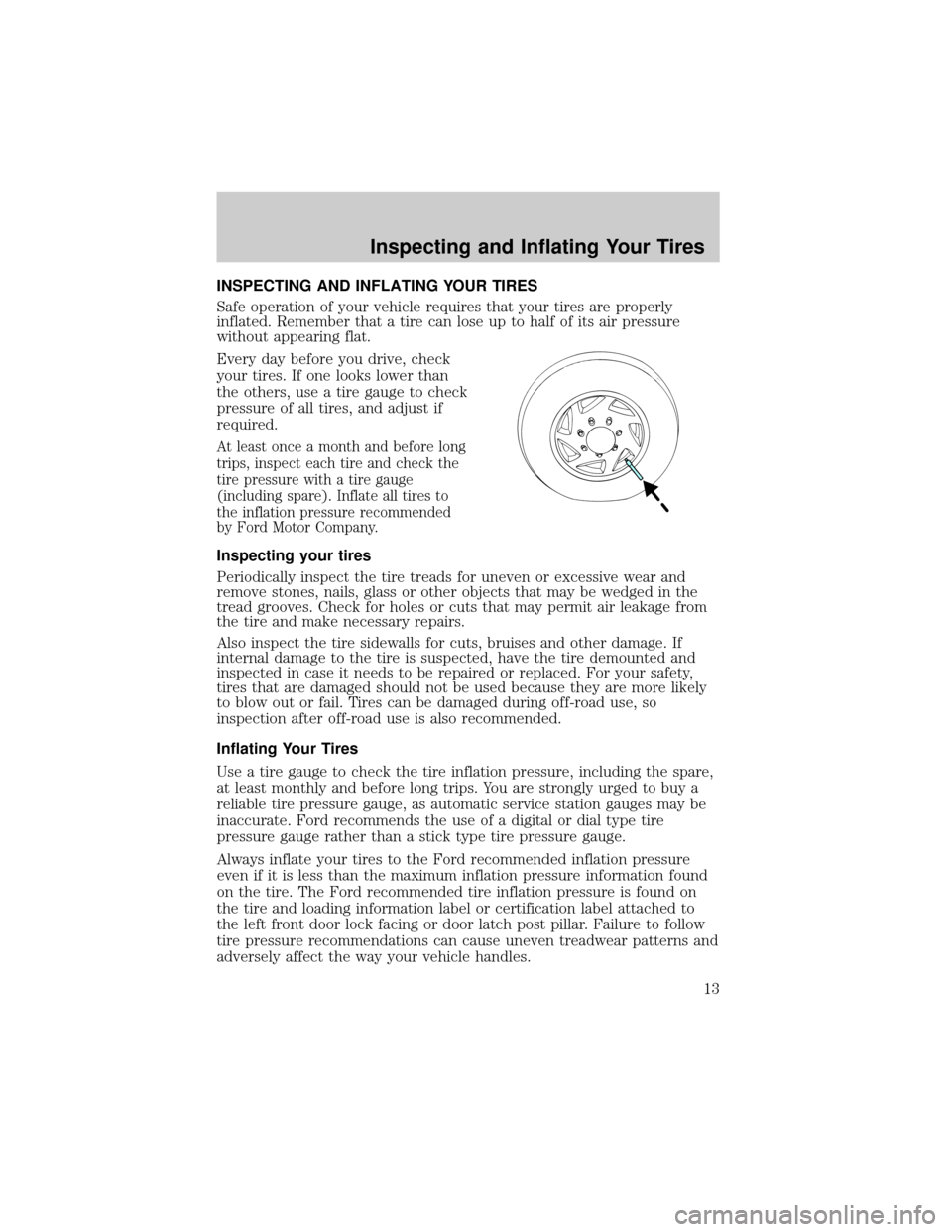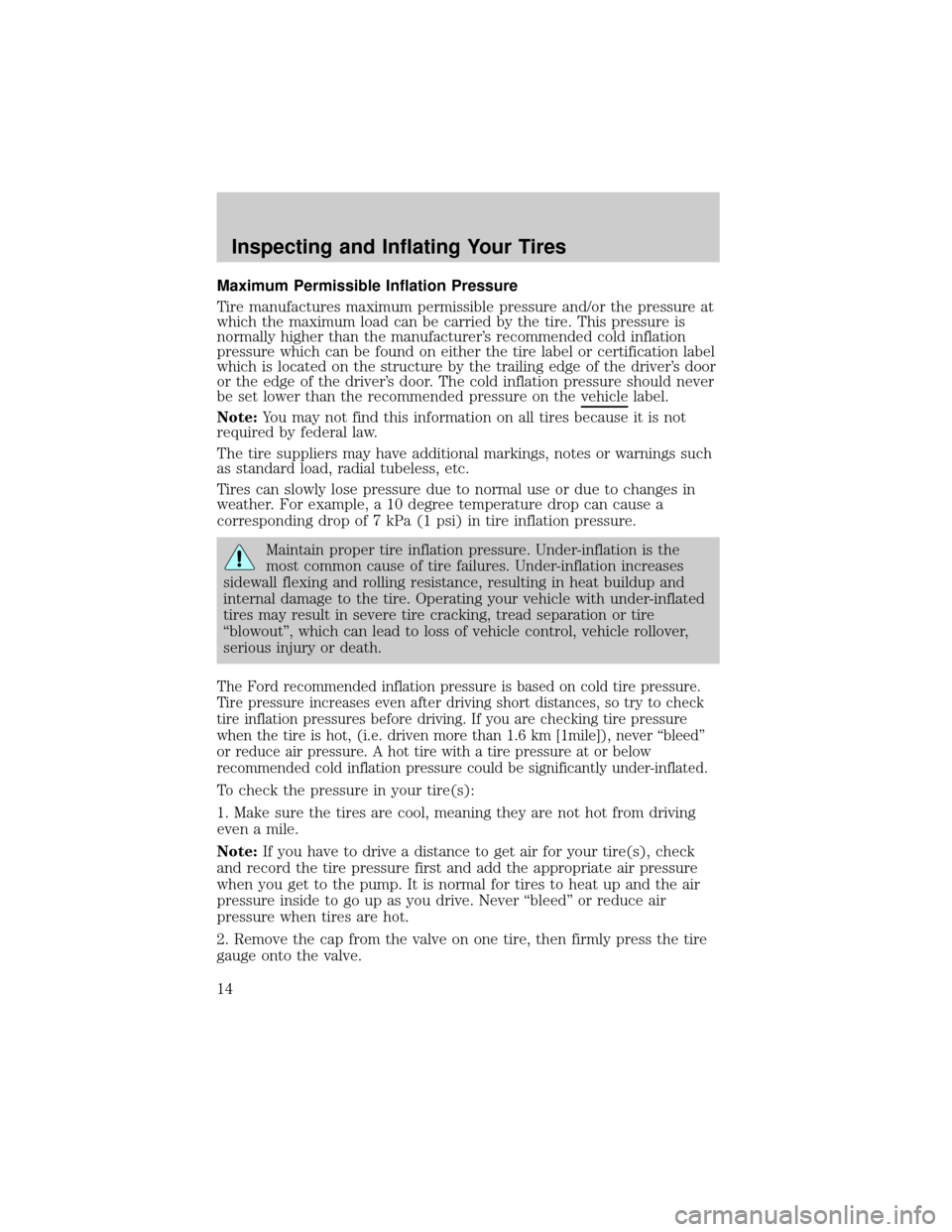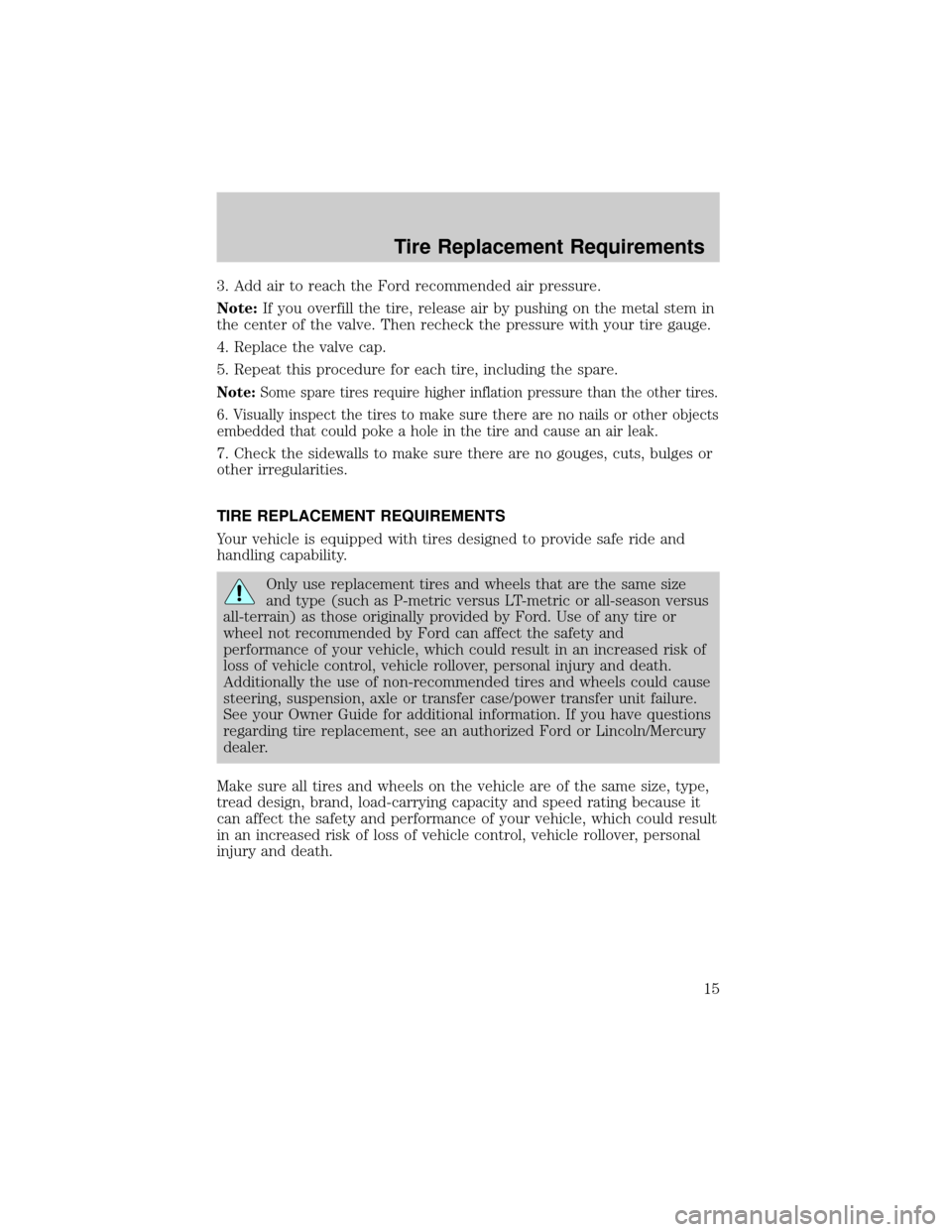inflation pressure Mercury Mountaineer 2007 Manual de Usuario (in Spanish)
[x] Cancel search | Manufacturer: MERCURY, Model Year: 2007, Model line: Mountaineer, Model: Mercury Mountaineer 2007Pages: 48, tamaño PDF: 0.37 MB
Page 37 of 48

INSPECTING AND INFLATING YOUR TIRES
Safe operation of your vehicle requires that your tires are properly
inflated. Remember that a tire can lose up to half of its air pressure
without appearing flat.
Every day before you drive, check
your tires. If one looks lower than
the others, use a tire gauge to check
pressure of all tires, and adjust if
required.
At least once a month and before long
trips, inspect each tire and check the
tire pressure with a tire gauge
(including spare). Inflate all tires to
the inflation pressure recommended
by Ford Motor Company.
Inspecting your tires
Periodically inspect the tire treads for uneven or excessive wear and
remove stones, nails, glass or other objects that may be wedged in the
tread grooves. Check for holes or cuts that may permit air leakage from
the tire and make necessary repairs.
Also inspect the tire sidewalls for cuts, bruises and other damage. If
internal damage to the tire is suspected, have the tire demounted and
inspected in case it needs to be repaired or replaced. For your safety,
tires that are damaged should not be used because they are more likely
to blow out or fail. Tires can be damaged during off-road use, so
inspection after off-road use is also recommended.
Inflating Your Tires
Use a tire gauge to check the tire inflation pressure, including the spare,
at least monthly and before long trips. You are strongly urged to buy a
reliable tire pressure gauge, as automatic service station gauges may be
inaccurate. Ford recommends the use of a digital or dial type tire
pressure gauge rather than a stick type tire pressure gauge.
Always inflate your tires to the Ford recommended inflation pressure
even if it is less than the maximum inflation pressure information found
on the tire. The Ford recommended tire inflation pressure is found on
the tire and loading information label or certification label attached to
the left front door lock facing or door latch post pillar. Failure to follow
tire pressure recommendations can cause uneven treadwear patterns and
adversely affect the way your vehicle handles.
Inspecting and Inflating Your Tires
Inspecting and Inflating Your Tires
13
Page 38 of 48

Maximum Permissible Inflation Pressure
Tire manufactures maximum permissible pressure and/or the pressure at
which the maximum load can be carried by the tire. This pressure is
normally higher than the manufacturer's recommended cold inflation
pressure which can be found on either the tire label or certification label
which is located on the structure by the trailing edge of the driver's door
or the edge of the driver's door. The cold inflation pressure should never
be set lower than the recommended pressure on the vehicle
label.
Note:You may not find this information on all tires because it is not
required by federal law.
The tire suppliers may have additional markings, notes or warnings such
as standard load, radial tubeless, etc.
Tires can slowly lose pressure due to normal use or due to changes in
weather. For example, a 10 degree temperature drop can cause a
corresponding drop of 7 kPa (1 psi) in tire inflation pressure.
Maintain proper tire inflation pressure. Under-inflation is the
most common cause of tire failures. Under-inflation increases
sidewall flexing and rolling resistance, resulting in heat buildup and
internal damage to the tire. Operating your vehicle with under-inflated
tires may result in severe tire cracking, tread separation or tire
ªblowoutº, which can lead to loss of vehicle control, vehicle rollover,
serious injury or death.
The Ford recommended inflation pressure is based on cold tire pressure.
Tire pressure increases even after driving short distances, so try to check
tire inflation pressures before driving. If you are checking tire pressure
when the tire is hot, (i.e. driven more than 1.6 km [1mile]), never ªbleedº
or reduce air pressure. A hot tire with a tire pressure at or below
recommended cold inflation pressure could be significantly under-inflated.
To check the pressure in your tire(s):
1. Make sure the tires are cool, meaning they are not hot from driving
even a mile.
Note:If you have to drive a distance to get air for your tire(s), check
and record the tire pressure first and add the appropriate air pressure
when you get to the pump. It is normal for tires to heat up and the air
pressure inside to go up as you drive. Never ªbleedº or reduce air
pressure when tires are hot.
2. Remove the cap from the valve on one tire, then firmly press the tire
gauge onto the valve.
Inspecting and Inflating Your Tires
14
Page 39 of 48

3. Add air to reach the Ford recommended air pressure.
Note:If you overfill the tire, release air by pushing on the metal stem in
the center of the valve. Then recheck the pressure with your tire gauge.
4. Replace the valve cap.
5. Repeat this procedure for each tire, including the spare.
Note:Some spare tires require higher inflation pressure than the other tires.
6. Visually inspect the tires to make sure there are no nails or other objects
embedded that could poke a hole in the tire and cause an air leak.
7. Check the sidewalls to make sure there are no gouges, cuts, bulges or
other irregularities.
TIRE REPLACEMENT REQUIREMENTS
Your vehicle is equipped with tires designed to provide safe ride and
handling capability.
Only use replacement tires and wheels that are the same size
and type (such as P-metric versus LT-metric or all-season versus
all-terrain) as those originally provided by Ford. Use of any tire or
wheel not recommended by Ford can affect the safety and
performance of your vehicle, which could result in an increased risk of
loss of vehicle control, vehicle rollover, personal injury and death.
Additionally the use of non-recommended tires and wheels could cause
steering, suspension, axle or transfer case/power transfer unit failure.
See your Owner Guide for additional information. If you have questions
regarding tire replacement, see an authorized Ford or Lincoln/Mercury
dealer.
Make sure all tires and wheels on the vehicle are of the same size, type,
tread design, brand, load-carrying capacity and speed rating because it
can affect the safety and performance of your vehicle, which could result
in an increased risk of loss of vehicle control, vehicle rollover, personal
injury and death.
Tire Replacement Requirements
Tire Replacement Requirements
15